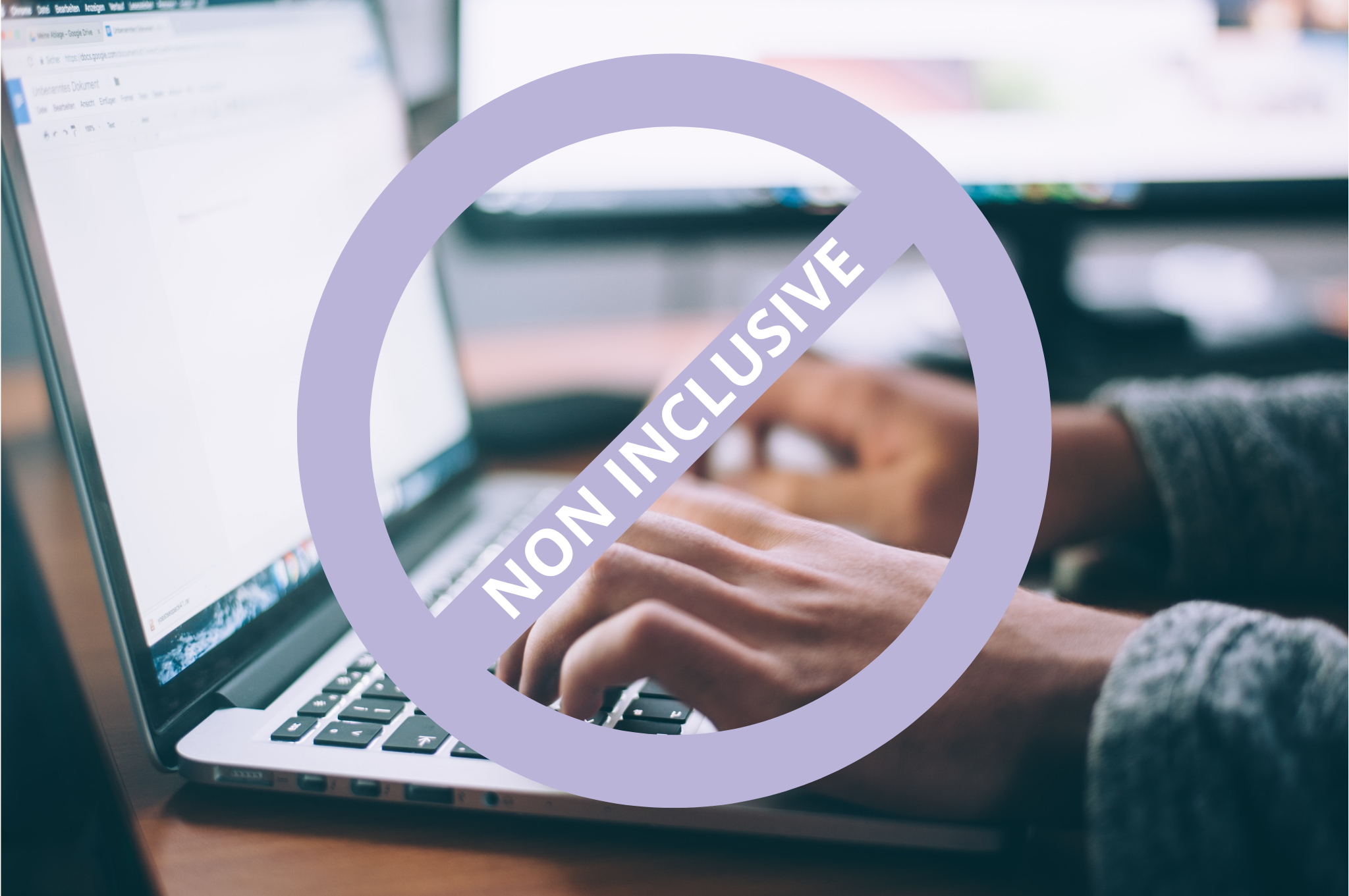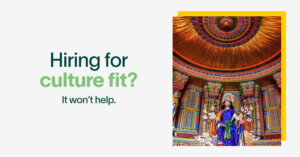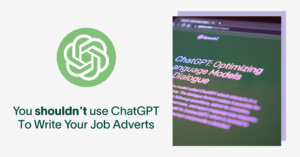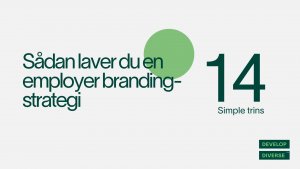The words you use in a job ad can say a lot about your organisation.
Every time a candidate reads your job advert, their brains are busily sorting through the words and skills that tell them what the role is. They’re sifting through phrases like ‘energetic worker’ and ‘coding ninja’, and interpreting what your organisation is like based on who they are, and how they self-identify.
And the problem is, you might be communicating more than you intended.
At Develop Diverse, we know from our own research that when just 0.6% of the words in a job advert are biased, it’s enough to stop a candidate from applying. In the average job advert, that’s just three words.
In this article, John Carpenter, chief of staff at 1st Formations, explains the red flags that make a job advert feel non-inclusive and provides some best practice tips to craft more inclusive job adverts at a junior, manager, and senior level.
What makes a job ad non-inclusive — and why does it matter?
Beyond the diversity statement, job ads can often be a breadcrumb trail of subtle clues as to what it’s like to work at your organisation.
Including a really long list of ‘must-have’ skills or desired personality traits for the role is the first red flag, says John. For one, job ads like this communicate unconscious bias on the type of person you expect to see in the role. And second, mentioning key personality traits gives a hint that you’re looking for cultural fit.
“One of the indicators that a job ad may not be inclusive enough is if the required skills go beyond the basic skillset required for the job, such as experience with certain platforms, and starts leaning too heavily into the personality of the candidate,” John says.
“Asking for candidates who are, for example, ‘young and energetic’ or ‘love to work hard and play hard’ can alienate candidates who are slightly older, have young children, or abstain from alcohol due to the cultural connotations associated with ‘playing hard’.”
Mentions of your culture, like the Friday bar, foosball table, or your Christmas party, may also communicate to candidates from different identity groups that your organisation won’t be a welcoming place for them. Your policies and practices, such as any mentions of maternity leave for example, may also feel non-inclusive — while industry jargon or acronyms may make your job ads feel impenetrable and confusing.
Language can be another red flag that your organisation isn’t welcoming to everyone.
“Certain roles do require a certain proficiency in particular languages,” John explains. “However, avoiding words like ‘native speaker’ and rather saying ‘proficient in English’ can encourage more foreign speakers to apply. For most roles, you don’t need to be a native speaker and have English as your first language in order to be productive. As long as you can communicate with co-workers and clients to a satisfactory level to do your job, that should be enough.”
How to write more inclusive job ads — with examples
Writing more inclusive job ads opens your organisation up to a more diverse talent pool, because it means that candidates are more likely to feel welcome to show up as themselves — with their own unique combination of personality, skills, and capabilities they bring to the table.
But what does that look like in practical terms? We’ll outline some best practice examples to follow.
For junior roles, focus on opportunities,
not experience
Pretty much all of us remember applying for our first job — and we probably all remember that feeling of knowing we didn’t fully meet the long list of required skills needed to apply. This is the experience for most junior candidates who are new to the workforce.
Simply put, you can’t get experience without having experience. The trouble is, most job ads require it. They also tend to require the qualifications that go along with it. A more inclusive switch might be focusing on opportunities for learning and growth, says John.
“Although for more senior roles, years in a particular industry may hold more significance, for an entry-level role, the most important thing is a candidate willing and motivated, and a candidate that’s easily mouldable,” he says. “When writing a job ad for a junior or entry-level role, a good way to ensure it appears inclusive is to place less focus on their years of experience in a certain industry and rather focus on promoting the opportunities for growth and training at your company.”
Inclusive switches for junior job ads
- Don’t say: “As a content marketing executive, the ideal candidate will have 3 years of experience in marketing or a related field and hold a relevant degree or qualification. The right candidate will have proven working knowledge of SEO best practice and is a self-starter who can deliver high-quality sales and marketing collateral in a fast-paced environment.”
- Do say: “As a content marketing executive, you get inspired by working on creative projects, and you like nothing better than finding interesting ways to get people’s attention with your words. You’re excited to learn how to apply your skills and motivation on-the-job with mentoring from our team.”
For manager or mid-level roles, look beyond years of experience
Often, mid-level or manager roles command a certain expectation around experience. They’re usually geared towards candidates with a certain level of years or training under their belt — which means that job ads can tend towards.
John says in this scenario, it’s much more effective to think about how someone has demonstrated the qualities of leadership — such as communication, interpersonal skills, or project management.
“In order to avoid the pitfalls of discriminating against candidates who don’t have a certain background, it’s best to focus on their skillsets rather than particular roles they’ve had or their academic qualifications,” John says. “In your job ad, target people who have experience in leadership roles rather than someone who’s necessarily been a manager in your industry — such as someone who’s worked in a role that requires them to communicate tasks.
“A schoolteacher might have more patience than the average corporate manager, the manager at a restaurant might have better logistical and organisational skills than the average corporate manager,” he adds. “It’s not about what you’ve done in the past, it’s about how you went about doing it.”
Inclusive switches for manager job ads
- Don’t say: “As a customer success team lead, you have 5 years of experience managing people. You’re a confident, ambitious leader who delegates effectively, with a strong track record for motivating others to achieve KPIs.”
- Do say: “As a team lead in our customer success team, you might have enjoyed taking the lead on projects or mentoring someone in a skill — whether in your professional life or outside of it. You’re a big believer in open communication, and you’re really good at seeing the bigger picture when working on a project.”
For senior leaders, address unconscious biases that keep diversity out of the board room
When recruiting senior leaders, CVs are reviewed and interviews are often done behind closed doors — either through executive recruitment, or from a pool of handpicked candidates. But with so little diversity at the top, everything you do to increase the diversity of your candidate pool means that more folks have access to opportunity beyond the cultural majority.
Gender, race, disability, and education bias still very much exist at the top. Breaking away the classic ‘male, pale, stale’ CEO cookie-cutter relies on crafting job adverts without that mental picture in mind.
“With senior/C suite-level roles, to make job descriptions appear more inclusive, it’s important to address the factors that might discourage someone going for certain roles,” John says.
“Offering remote working opportunities may not only encourage candidates of all genders, ethnic backgrounds and family arrangements to apply, but also demonstrate that you’re truly looking for the best person for the job. It is hard to completely neutralise unconscious biases but making appropriate efforts to make a role as accessible as possible can certainly help.”
Inclusive switches for senior leader job ads
- Don’t say: “The right candidate for our Chief Marketing Officer at Acme Corp has significant B2B marketing experience and is able to bring an analytical mindset to marketing operations. He is a confident and assertive leader who has an ability to thrive under pressure and operationalise our GTM strategy.”
- Do say: “As a Chief Marketing Officer at Acme Corp, you’ll be responsible for guiding our large marketing team, and developing positioning that helps us maximise our growth. You’re comfortable blending data and creativity to achieve business results.”
__
Develop Diverse is an inclusive communication platform that enables organisations to build in the communication norms that build more inclusive, diverse workplaces. Based on a combination of cutting-edge research and AI, Develop Diverse’s text analysis tool helps organisations proactively spot discrimination and bias in written text, make inclusive switches, and scale a culture of inclusive communication across the whole company.





